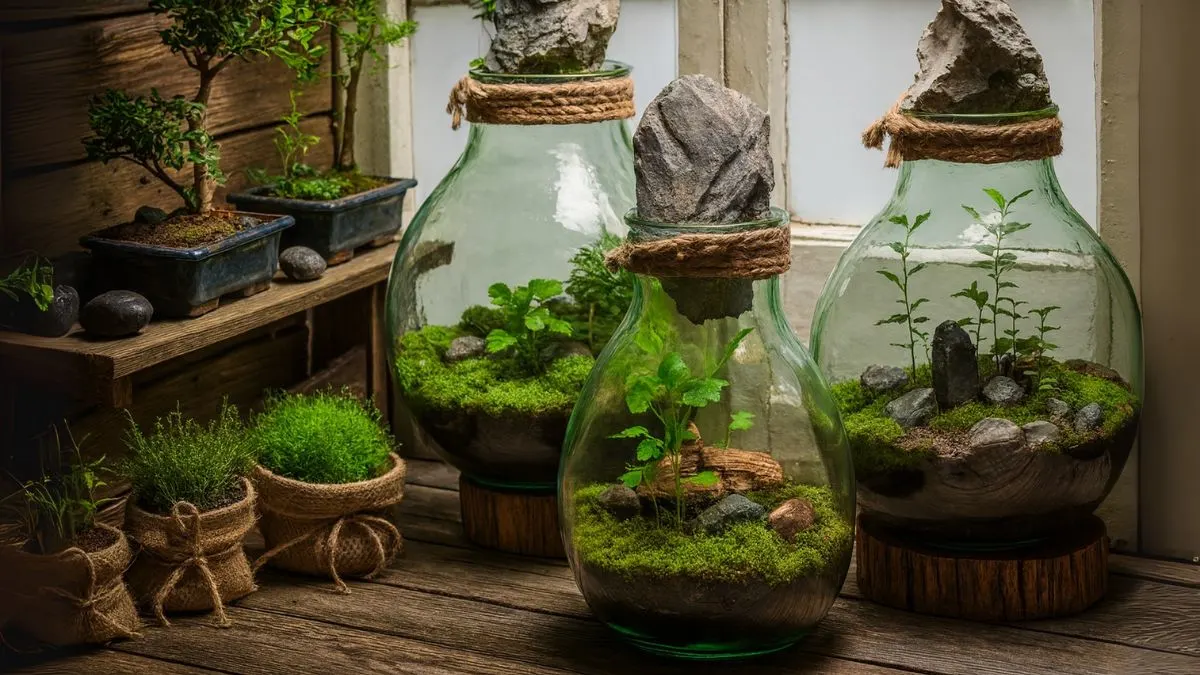Terrariums are like little worlds of green magic—tiny ecosystems that bring beauty, calm, and nature right into your living space. Unlike regular houseplants, terrariums require a specific balance of light, moisture, and airflow. The good news? With just a few mindful steps, you can keep your miniature garden thriving for years.
In this beginner-friendly guide, you’ll learn the essentials of how to care for a plant terrarium, from proper watering to handling mold. I’ll also share personal experiences that made my terrariums flourish (and a few mistakes I learned from).
Choosing the Right Spot for Your Terrarium

Lighting is one of the most important factors. Always place terrariums in locations with filtered or indirect sunlight. Direct sun can create a “greenhouse effect” inside the glass, overheating and burning delicate plants.
For terrariums in North American homes—whether in Canada’s colder regions or sunny US states—placing them near east- or north-facing windows works best. If natural light is limited, low-intensity grow lights are a reliable alternative.
Managing Humidity and Mold
Terrariums are closed or semi-closed environments, which means moisture can get trapped inside. While this is beneficial for tropical plants, it can sometimes lead to fungal growth. Remember, plants that require high humidity might develop mold or rot in a drier environment—or if the balance is off.
Quick Tips to Control Humidity:
- Open the terrarium lid for a few hours if condensation builds up.
- Use activated charcoal in the soil layer to reduce mold risk.
- Remove any leaves that show signs of decay immediately.
Also Read: Bring Home These 10 Water Plants for Beauty, Peace & Clean Air
Watering Your Terrarium Correctly
Overwatering is the number one reason terrariums fail. Since glass containers don’t have drainage holes, you’ll need to be extra careful. A spray bottle or dropper works well for adding controlled amounts of water.
A simple rule: water lightly when the soil looks dry but avoid soggy conditions. Succulent-based terrariums require even less water than fern or moss-filled ones.
Pruning and Propagation
As plants grow, they can quickly outgrow their tiny homes. Regular trimming is essential. One of my favorite terrarium tricks is to prune back your plants and reuse the cuttings. Many small plants, like ferns, pothos, or nerve plants, can root easily in moist soil.
This not only prevents overcrowding but also lets you start new terrariums or gift plant cuttings to friends.
Terrarium Care Table: Do’s and Don’ts
Care Step |
Do |
Don’t |
Light |
Place terrariums in locations with filtered or indirect sunlight |
Don’t put in harsh direct sun |
Water |
Mist lightly, monitor soil |
Don’t drench or flood |
Humidity |
Ventilate when too wet |
Don’t ignore mold buildup |
Pruning |
Prune back your plants and reuse the cuttings |
Don’t let plants overcrowd the space |
Troubleshooting Common Issues
- Yellowing Leaves: Often caused by overwatering. Reduce moisture and allow the soil to dry slightly.
- Mold Growth: If you see fuzzy white patches, act quickly. Open the terrarium for airflow, remove the affected leaves, and consider sprinkling a little cinnamon powder as a natural antifungal remedy.
- Plants Outgrowing the Space: When plants start pressing against the glass, trim them back. Alternatively, move the larger ones to a separate pot and replant smaller species inside.
Also Read: Grow a Lotus Plant at Home and Watch Peace Bloom Daily
Personal Experience with Terrariums
When I built my first terrarium, I placed it on a sunny windowsill. Within days, the glass fogged up, and mold appeared. After trial and error, I learned to place terrariums in locations with filtered or indirect sunlight and open the lid occasionally. The transformation was amazing.
Now, I regularly prune back my plants and reuse the cuttings, which keeps them compact and healthy. That first terrarium has been alive for over two years—and it’s become my favorite indoor accent.
Caring for a terrarium is about creating balance—light, water, air, and growth. By remembering the basics—filtered sunlight, pruning cuttings, and humidity control—you can enjoy a thriving little ecosystem that lasts for years. So next time you think of bringing greenery into your space, don’t just buy another houseplant. Try a terrarium. It’s not just décor; it’s a living, breathing world right on your desk or shelf.






